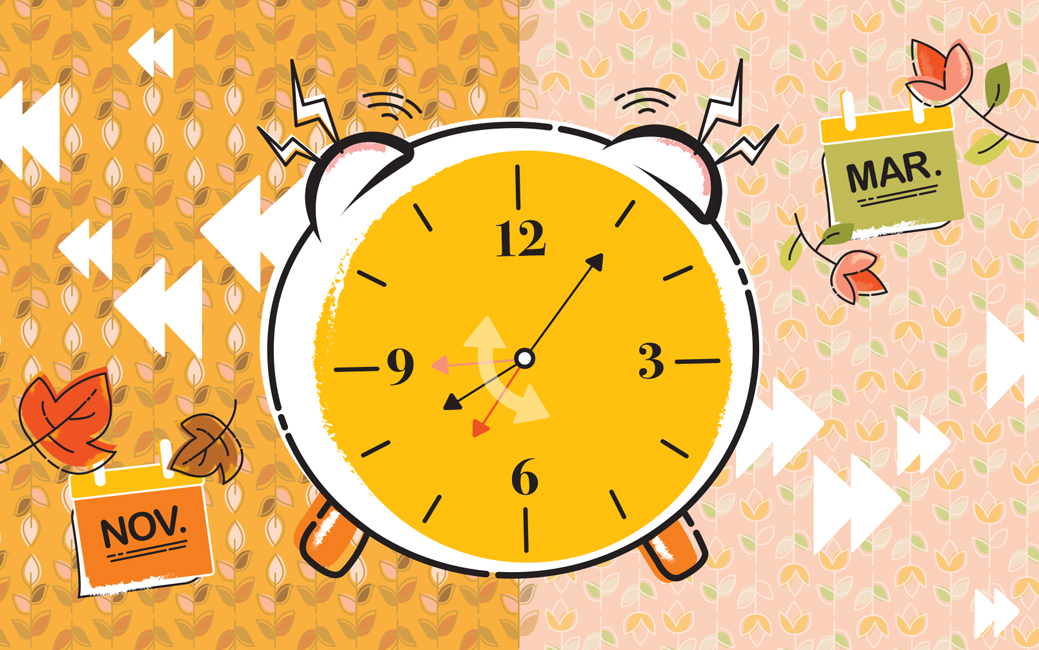Office Hours: Daylight Saving Time
Geography professor Martin Roberge on why we have it and what can go wrong when we don’t understand it.

Standard time across the United States’ four time zones was established on March 1, 1918. In the same act of Congress, daylight saving time was created. Just a year later, daylight saving time was repealed, and it wasn’t until Lyndon Johnson signed the Uniform Time Act of 1966 that it was federally standardized.
In 1974, Nixon signed a law that made daylight saving permanent year-round. But it lasted less than a year because the very first winter, everybody hated it. You had to get up early, and it was dark out. People didn’t realize how bad it would be in the winter.
I think most people hate switching back and forth. There are plenty of medical studies against it, and everybody has a story of showing up an hour early or an hour late. Most people agree that it needs to stop.
What’s strange is any time we want to, we can. A state just has to say, “OK, we’re no longer going to be switching to daylight saving time.” And then the state is unilaterally allowed to pull out of it.
We could stop the madness any time we want. But to switch to permanent daylight saving time nationally, you’d have to pass another law.
The thing is, you’re not really saving any time. Every day is always 24 hours. In the summer you get lots of extra daylight, and you get very little darkness. And then in the winter you get lots of darkness and very little sunlight. That’s why it’s cold in winter. It’s just the way the sun works.
“ We could stop the madness any time we want. But to switch to permanent daylight saving time nationally, you’d have to pass another law. ”
What you’re doing with daylight saving is you’re getting everybody to wake up an hour earlier. It’s kind of like a trick. It sounds like a great idea. But it’s against our circadian rhythms to wake up when it’s dark out. Or go to bed when it’s still sunny out.
People have suggested workarounds like pretending to be in a time zone ahead of yours, but time zones are confusing enough without people switching back and forth.
For example, when we had mechanical watches, you’d get on an airplane, and you’d have to change your watch. If you didn’t, you’d miss the second leg of your flight to San Francisco, because you thought you had 45 minutes. Now our phones just take care of it for us.
It turns out the information behind the automatic changing is completely on the shoulders of a bunch of volunteers. They run a historical database that keeps track of every clock change that anybody anywhere made since 1970.
Devices probably have multiple copies of this database because they have to know what time it is. If you want to do a Zoom call with somebody in Japan, are they doing daylight saving, and do they have any weird rules about it? When are they switching on, and when do they switch off? Did they pass any laws recently that changes that date?
Just to schedule that call, we need a copy of this database. If there was a mistake, somebody would be malicious or if the volunteers were to rise up—any one of these things would mess things up very badly.
It started with one guy who needed to keep track of time changes for his own purposes way before the internet, and he shared it with others. There’s just so much infrastructure relying on an ad hoc group of people.
Your computer, your cell phone, every computer operating system—anybody who wants to know the local time needs a copy of this database. If Turkmenistan decides they want to go to permanent daylight saving time tomorrow, there would be an update, and everybody’s computers and phones would all have to get a copy of the update.
In 2007, the United States unilaterally decided to make daylight saving end later and start earlier. Any country can do that. Mexico recently got rid of daylight saving and went to permanent standard time. Most of Asia got rid of daylight saving at some point.
China only has one time zone. So when you say it’s 12 p.m., everybody knows it’s 12 p.m. Which is a little weird because sunrise might be three hours earlier in one place than it is in another.
But at least the clocks are all the same.
